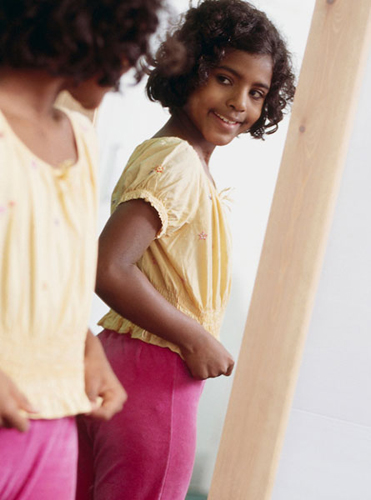What to expect during puberty Physical changes
As puberty begins,
your child’s body undergoes the physical changes necessary to take her
from childhood to adulthood. It is the hormone testosterone, produced by
the testes, that kicks off puberty for boys, and for girls it is
estrogen, produced by the ovaries, that gets things going. These
hormones, also known as chemical messengers, start and stop bodily
changes.
Puberty usually starts
for girls between the ages of nine and 13 and, for boys, from 10 to 15.
The exact timing for your child will depend on genetics; a child’s age
at the onset of puberty is often similar to that of his or her parent of
the same sex.
Educate your child on what
to expect during puberty. When she knows what comes next she’ll be more
ready and able to adapt to her changing body. This may involve a long
heart-to-heart at first followed up by frequent short conversations as
questions come up for her.
Ensure your discussions
on the subject are in private, and leave her with books about how
puberty affects both boys and girls so that she can find more details at
her leisure. Frequently mothers talk this through with daughters and
fathers with sons. However, there is no hard and fast rule: Give your
child the choice of whether she speaks to one of you or both at times.
On the outside
Penis and testicles
Your son will notice his
testicles and penis grow. This could start as early as age 10 to 11
but, for most, will be around 13 to 14.
Breasts and body shape
The first sign of
puberty in your daughter is likely to be breast development, beginning
with the creation of “breast buds” as her nipples swell, followed by
gradual growth of breast tissue, filling out around age 12 to 13 for
most girls. Her hips will also widen as her body becomes more womanly
and less boyish.
Height
With puberty comes a
growth spurt. Your child’s rate of growth, averaging around 2–21/4
inches (5–6 cm) a year so far, will accelerate for your daughter to
about 31/2 inches (9 cm) a year, with the peak of her growth around age
12. Your son’s spurt will probably be a little later. He’ll gain about 4
inches (10 cm) in height a year, most noticeably between the ages of 14
and 15, but starting as young as 12 or 13 for some.
Hair
Pubic, followed by
underarm, hair will start to grow for both boys and girls. Your son will
also develop facial and chest hair, and you might find him frequently
examining himself in the mirror for fuzz on his upper lip.
Voice
Your son’s voice will
deepen around age 14 to 15 as testosterone lengthens and thickens his
vocal cords. This may be a gradual process, or he may at times have his
usual, higher voice, and then, perhaps comically to you but possibly to
his embarrassment, his tone will suddenly deepen. Eventually this deeper
voice will be a permanent feature. He will also notice an Adam’s apple
as his vocal cords tilt, showing up as a lump on his throat. Your
daughters’ voice will also deepen a little, usually later, roughly
between ages 15 and 16.
Sweat
Your child’s sweat
glands will become more active and skin can be affected by acne. Pimples
are usually a little worse for boys than girls and are caused when
sebum, an oil that works to keep skin soft and supple, is overproduced
and blocks pores. Keeping skin clean helps reduce the occurrence of
pimples, and good personal hygiene is a must in general, because all
that sweat can create body odor if soap is not used regularly. You may
need to remind your child about this.
On the inside
The ability to reproduce
Alongside the visible
signs of puberty, your child’s body is becoming ready to reproduce. Your
daughter is likely to reach maturity in this area first, with
menstruation (also known as her period or “time of the month”),
beginning when she is between the ages of nine and 17, with most girls
starting at age 13 to 14. Menstruating is the sign that the lining of
her uterus is able to sustain a fetus. It may also mean her ovaries are
releasing eggs, but periods can occur, at least at first, without eggs
being produced. Your daughter will cope more easily with her first
periods if she is well prepared about what to expect, familiar with how
to use and dispose of pads or tampons, and knows how to maintain
personal hygiene.
Your son will begin to
produce mature sperm sometime between the ages of 11 and 17; most boys
have reached this stage by age 15. This means his sperm will be able to
fertilise an egg and create a baby. He will handle these changes more
confidently if you’ve explained in advance about erections, ejaculation,
and wet dreams.
Even though you may
feel your child isn’t ready for sexual relationships yet, both your son
and daughter need to be educated, or reminded, about contraception and
the meaning of intimacy in relationships.
When to worry
There is considerable
variation in the timing of pubescent development. It will happen in its
own time, whether your child wishes it to be sooner or later. However,
for a very small number of children there may be a medical issue which
affects the timing of puberty. If your child is not showing any signs of
puberty, such as the beginnings of breast or testicle development, by
the age of 14, seek a medical opinion from your pediatrician.
Educate
It is very important that
you explain the physical and emotional changes of puberty to your child.
If he or she knows what to expect, it will make this time easier.
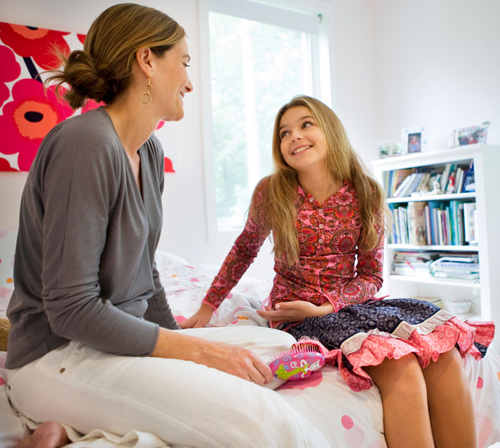
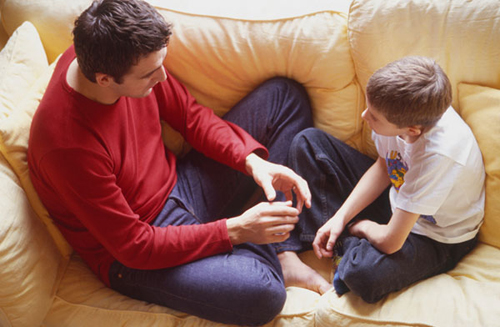
Moustache
Your son will start to grow facial hair, starting with a light covering on the upper lip.
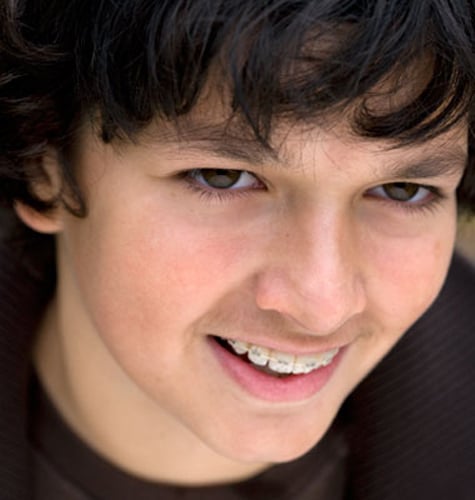
Keeping clean
Help your child with personal hygiene by providing deodorant.
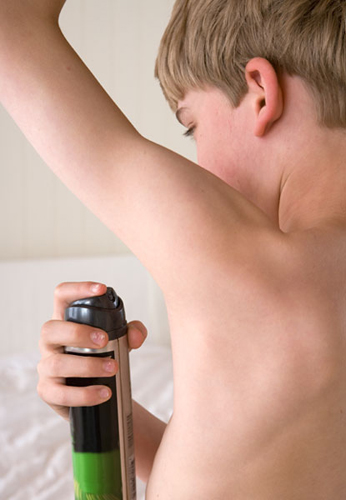
First bra
Buying new underwear will help her feel comfortable with her changing body.

Baby fat and other issues Achieving a healthy body image
Changes in body shape are an
inevitable aspect of puberty. Your child may become very concerned
about her appearance—including her size, skin, and pimples—and her rate
of development, especially if she is earlier or later than her peers in
showing signs of puberty. It is commonly said that children lose their
“baby fat” at puberty, however this is not the case. If your child is
overweight in the early years she is likely to continue to be large as
she matures, unless changes in diet and activity level are made. An
additional factor in weight change at puberty is that time spent playing
sports and being physically active tends to drop as your child reaches
middle school. This reduction in exercise can affect her weight while,
at the same time, she is experiencing an increase in consciousness of
her shape and size. Your role is to support your child’s healthy
lifestyle and sympathize with her worries without being patronizing or
minimizing her concerns. This is no easy feat, and you may feel like
you’re walking on eggshells trying to be sensitive without implying
there is a problem.
Help her gain a healthy view of her body
Include healthy
eating and regular exercise as part of your routine for the whole
family. A balanced diet at puberty helps with general well-being and
benefits adolescent skin conditions. When the whole family is involved,
your child does not feel singled out or that you’re implying she is
overweight or unhealthy.
Accept
her no matter what. Compliment her on her achievements, appearance, and
personal qualities to balance her own self-criticism.
Watch
what you say: Comparisons with others or joking comments about puberty
or her appearance can be deeply hurtful to your child even though you
don’t mean any offense.
Understand
and be sensitive to her concerns about her appearance. Reassure her
that you love her and how she looks, but acknowledge she may not feel
this way herself. Offer practical help if she raises a specific problem.
For example, assistance on a bad hair day or to conceal pimples is
often appreciated, even if all you do is buy her the product she needs
rather than fuss over the application.
I want to be like you
If your child’s concerns about her body cause her distress, for example becoming obsessed with skinny models in magazines (see image), get advice and support from a doctor or youth counselor.
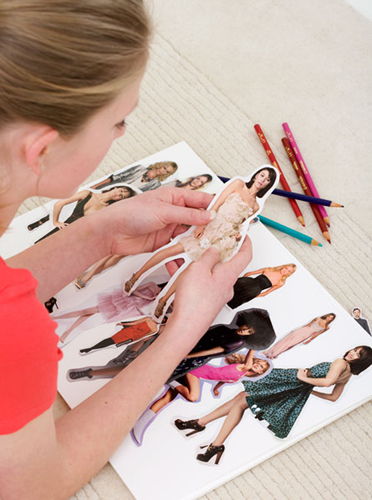
How do I look?
Help your child develop a healthy body image (see image), by being sensitive and reassuring about her appearance.
